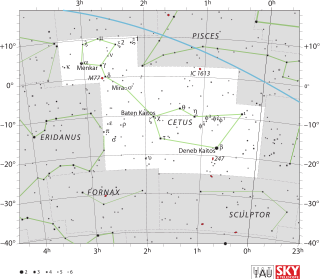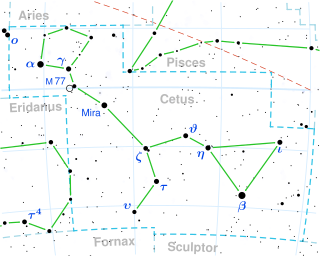Gliese 65, also known as Luyten 726-8, is a binary star system that is one of Earth's nearest neighbors, at 8.8 light-years from Earth in the constellation Cetus. The two component stars are both flare stars with the variable star designations BL Ceti and UV Ceti.
79 Ceti, also known as HD 16141, is a binary star system located 123 light-years from the Sun in the southern constellation of Cetus. It has an apparent visual magnitude of +6.83, which puts it below the normal limit for visibility with the average naked eye. The star is drifting closer to the Earth with a heliocentric radial velocity of −51 km/s.

60 Sagittarii is a suspected binary star system in the southern constellation of Sagittarius. It has the Bayer designation A Sagittarii, while 60 Sagittarii is the Flamsteed designation. This naked-eye object forms the northwest corner of the asterism called the Terebellum and, with an apparent magnitude of approximately 4.84, it is the dimmest of the four stars in the Terebellum. It is located 379 light-years from the Sun, based on parallax, but is moving closer with a radial velocity of −51 km/s.

Epsilon Aquilae, Latinized from ε Aquilae, is the Bayer designation for a binary star system in the equatorial constellation of Aquila, near the western constellation boundary with Hercules. It has an apparent visual magnitude of 4.02 and is visible to the naked eye. Based upon an annual parallax of 23.993 mas, Epsilon Aquilae lies at a distance of approximately 136 light-years from Earth, but is drifting closer with a radial velocity of –46 km/s.
14 Boötis is a possible binary star system located 110 light years away from the Sun in the northern constellation of Boötes. It is visible to the naked eye as a dim, yellow-white hued star with a combined apparent visual magnitude of 5.53. This system is moving closer to the Earth with a heliocentric radial velocity of −40 km/s. It has a relatively high proper motion, traversing the celestial sphere at the rate of 0.260 arc seconds per annum.

Gamma Ceti is a triple star system in the equatorial constellation of Cetus. It has a combined apparent visual magnitude of 3.47. Based upon parallax measurements, this star is located at a distance of about 80 light-years from the Sun.

Zeta Capricorni, Latinised from ζ Capricorni, is a binary star system in the southern constellation of Capricornus. It is visible to the naked eye with an apparent visual magnitude of 3.77. The system is located at a distance of approximately 386 light-years from the Sun based on parallax. It is drifting further away with a radial velocity of +2 km/s. The absolute magnitude of this system is −1.59.

Xi1 Centauri, Latinized from ξ1 Centauri, is a solitary star in the southern constellation of Centaurus. It is visible to the naked eye with an apparent visual magnitude of +4.83. With an annual parallax shift of 14.79 mas, it is located around 221 light years from the Sun. At that distance, the apparent visual magnitude of the star is diminished by an interstellar extinction factor of 0.10 due to intervening dust. Just 17 arc minutes to the east of Xi1 Centauri lies the galaxy NGC 4945.

Zeta Cygni is a binary star system in the northern constellation of Cygnus, the swan. It has an apparent visual magnitude of 3.26 and, based upon parallax measurements, is about 143 light-years away.
Pi Cephei is a trinary star located in the constellation Cepheus. With a combined apparent magnitude of about 4.4, the system is faintly visible to the naked eye. The inner pair of stars orbits in 1.5 years while the outer companion completes one orbit in about 160 years.

EQ Virginis is a single variable star in the equatorial constellation of Virgo. It has a baseline visual apparent magnitude of 9.36, but is a flare star that undergoes sporadic bursts of brightening. The star is located at a distance of 67 light-years from the Sun based on parallax measurements, but is drifting closer with a radial velocity of −23 km/s. It is a member of the IC 2391 moving group of stars, which is between 30 and 50 million years old.

Xi Piscium (ξ Piscium) is an orange-hued binary star system in the zodiac constellation of Pisces. In 1690, the astronomer Johannes Hevelius in his Firmamentum Sobiescianum regarded the constellation Pisces as being composed of four subdivisions. Xi Piscium was considered to be part of the Linum Austrinum, the South Cord. The star is visible to the naked eye, having an apparent visual magnitude of 4.60. Based upon an annual parallax shift of 11.67 mas as seen from Earth, it is located about 280 light years from the Sun. It is moving away from the Sun, having a radial velocity of +26 km/s.

Mu Ceti is a star in the constellation Cetus. The combined apparent magnitude of the system is +4.27, and it is located 84 light-years from the Sun.

ν Ceti, Latinized as Nu Ceti, is a binary star system in the equatorial constellation of Cetus. It is visible to the naked eye as a faint point of light with a combined apparent visual magnitude of 4.86. The system is located approximately 340 light years distant from the Sun, based on parallax, and is drifting further away with a radial velocity of 4.8 km/s. Nu Ceti is believed to be part of the Ursa Major stream of co-moving stars.
Xi2 Ceti, Latinized from ξ2 Ceti, is a star located in the equatorial constellation of Cetus. It is visible to the naked eye with an apparent visual magnitude of +4.3. This star is located at a distance of approximately 197 light years from the Sun based on parallax, and is drifting further away with a radial velocity of 12 km/s. It made its closest approach some 2.7 million years ago at a distance of around 128 light-years.
75 Ceti is a single star in the equatorial constellation of Cetus with at least two planets. It is visible to the naked eye as a dim, orange-hued star with an apparent visual magnitude of +5.36. The star is located 268 light-years distant from the Sun, based on parallax, but is drifting closer with a radial velocity of −6 km/s.

56 Pegasi is a binary star system in the northern constellation of Pegasus. It is visible to the naked eye with a combined apparent visual magnitude of 4.74. The system is approximately 590 light years away from the Sun based on parallax, but is drifting closer with a radial velocity of −28 km/s. It is listed as a member of the Wolf 630 moving group.

Xi1 Lupi (ξ1 Lup, ξ1 Lupi) is a probable binary star in the southern constellation of Lupus. It is faintly visible to the naked eye with an apparent visual magnitude of 5.1, and forms a visual double star with Xi2 Lupi. Based upon an annual parallax shift of 23.60 mas as seen from Earth, it is located around 140 light-years from the Sun. It is a member of the Upper Scorpius sub-group of the nearby Sco OB2 association.
16 Serpentis is a binary star system in the Serpens Caput portion of the equatorial constellation of Serpens, located 228 light years from the Sun. It is visible to the naked eye as a fain, orange-hued star with an apparent visual magnitude of 5.261. The system is moving further from the Earth with a heliocentric radial velocity of +3 km/s.
HD 136138, or HR 5692, is a binary star system in the Serpens Caput segment of the Serpens constellation. It has a golden hue like the Sun and is dimly visible to the naked eye with an apparent visual magnitude of 5.68; the light contribution from the companion is effectively negligible. This system is located at a distance of approximately 420 light years from the Sun based on parallax. It is drifting closer with a radial velocity of −7.7 km/s and has a proper motion of 23.5 mas·yr−1.











